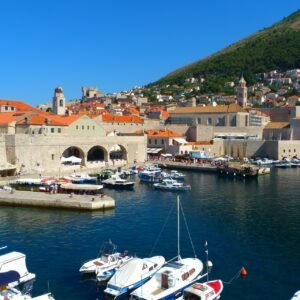Geographic and Demographic Details of Slovakia
Slovakia, centrally situated in Europe, shares its borders with five countries: the Czech Republic to the northwest, Austria to the southwest, Poland to the north, Ukraine to the east, and Hungary to the south. The nation’s strategic position has made it a cultural and logistical hub in the region.
The topography of Slovakia is notably diverse. The northern part of the country is dominated by the Carpathian Mountains, including the High Tatras, which are renowned for their towering peaks and winter sports opportunities. The southern regions descend into fertile lowlands, making way for extensive agricultural activities. Slovakia is also home to significant river systems, with the Danube River forming part of its southern border and the Váh River being the longest river entirely within Slovakia’s boundaries.
Slovakia’s climate varies significantly between its regions. The mountainous areas in the north experience a cooler, alpine climate, characterized by cold winters and mild summers. In contrast, the lowland areas to the south enjoy a temperate climate with warmer summers and milder winters. This climatic diversity contributes to a rich natural environment that supports various outdoor activities and tourism.
Demographically, Slovakia has a population of approximately 5.4 million people. The ethnic composition is predominantly Slovak, making up about 80% of the population, while other significant ethnic groups include Hungarians, Roma, Czechs, and Ruthenians. The official language is Slovak, but Hungarian and Roma communities often use their native languages.
Culturally, Slovakia boasts a rich heritage influenced by its diverse ethnic groups as well as historical connections with neighboring countries. Traditional Slovak folklore, music, dance, and cuisine are still vibrant and widely celebrated. The country’s blend of modern living with strong cultural traditions creates a unique societal tapestry that contributes to Slovakia’s charm.
Top Cities and Tourist Attractions in Slovakia for Summer and Winter
Slovakia boasts a range of cities and attractions that cater to visitors in both summer and winter seasons. At the heart of Slovakia is the capital city, Bratislava. Known for its historic old town, Bratislava is a city where history and modernity coalesce. Visitors can stroll through the pedestrian-friendly old town, exploring landmarks such as the Bratislava Castle, perched on a plateau overlooking the river Danube, and the Primate’s Palace known for its stunning Hall of Mirrors. The vibrant cultural scene, complemented by numerous museums, art galleries, and theaters, ensures that visitors are constantly engaged.
Another notable city is Košice, the second-largest city in Slovakia. Košice is famed for its historical architecture, including the magnificent St. Elisabeth Cathedral, the largest church in Slovakia. The city also has a rich cultural tapestry, featuring numerous art galleries and museums. The main street, Hlavná ulica, is quintessentially European with its charming cafes, boutiques, and historic buildings, making it a pleasant spot for wandering and discovering local flavors.
Banská Bystrica, though smaller, is imbued with charm and history. Nestled in the mountains, it offers picturesque streets lined with colorful, traditional houses and landmarks such as the SNP Square and the Clock Tower. Its location makes it the perfect gateway to the surrounding mountainous regions, appealing to nature lovers and history enthusiasts alike.
For summer tourism, Slovakia’s natural landscapes provide a bevy of destinations. The High Tatras, a mountain range with striking peaks and serene lakes, attract hikers and nature enthusiasts. Similarly, national parks like Slovak Paradise offer lush forests and intricate cave systems, making them ideal for adventurous exploration.
In winter, Slovakia transforms into a haven for winter sports aficionados. The Low Tatras, home to premier ski resorts such as Jasná, offer extensive slopes catering to different skill levels. Visitors can indulge in skiing, snowboarding, and other winter sports activities. This region, rich with snow-blanketed landscapes and cozy lodges, epitomizes the quintessential winter getaway.
In essence, Slovakia’s cities and tourist attractions offer a diverse array of activities and experiences, ensuring that every season brings a unique opportunity to explore and enjoy this captivating country. Whether one is drawn to historical explorations, cultural immersion, or nature adventures, Slovakia has something to offer year-round.
International Airports and Slovakia’s Global Connectivity
Slovakia’s international airports serve as crucial hubs for its global connectivity, offering travelers access to a broad network of flights. The principal gateway for international air travel is Bratislava Airport (BTS). As Slovakia’s largest and busiest airport, Bratislava Airport facilitates numerous direct flights to major European cities such as London, Berlin, Vienna, and Prague, amongst others. The airport also provides connections to other global destinations, making it an essential conduit for international visitors and outbound Slovak travelers alike.
Bratislava Airport is well-equipped with modern amenities to ensure a seamless travel experience. Passengers benefit from a variety of services, including dining options, duty-free shopping, and efficient customs procedures. The airport’s strategic location, merely 9 kilometers from Bratislava’s city center, is supported by excellent transportation links. Shuttle services, buses, taxis, and car rentals ensure easy access to the city and beyond, connecting tourists to Slovakia’s cultural and natural attractions.
In addition to Bratislava Airport, Košice International Airport (KSC) plays a pivotal role in Slovakia’s global connectivity. Serving the eastern part of the country, Košice International Airport offers direct flights to prominent European destinations like Vienna, London, and Prague. The airport is situated approximately 6 kilometers from Košice’s city center, facilitating easy access through various transportation means, including buses and taxis that connect the airport to the city’s heart and surrounding areas.
Poprad-Tatry Airport (TAT), though smaller in scale, is another key international airport in Slovakia, particularly serving the region of the High Tatras, a major tourist attraction. It connects Slovakia to destinations such as London and Riga. Poprad-Tatry Airport’s proximity to the Tatra mountains makes it an ideal entry point for tourists looking to explore Slovakia’s natural beauty. Efficient transport options, such as buses and taxis, enable seamless movement from the airport to nearby towns and tourist spots.
Overall, Slovakia’s network of international airports not only enhances the country’s global connectivity but also plays a vital role in supporting tourism and trade. With well-coordinated transport facilities, these airports ensure that both international and domestic travelers experience convenience and accessibility as they explore all that Slovakia has to offer.




